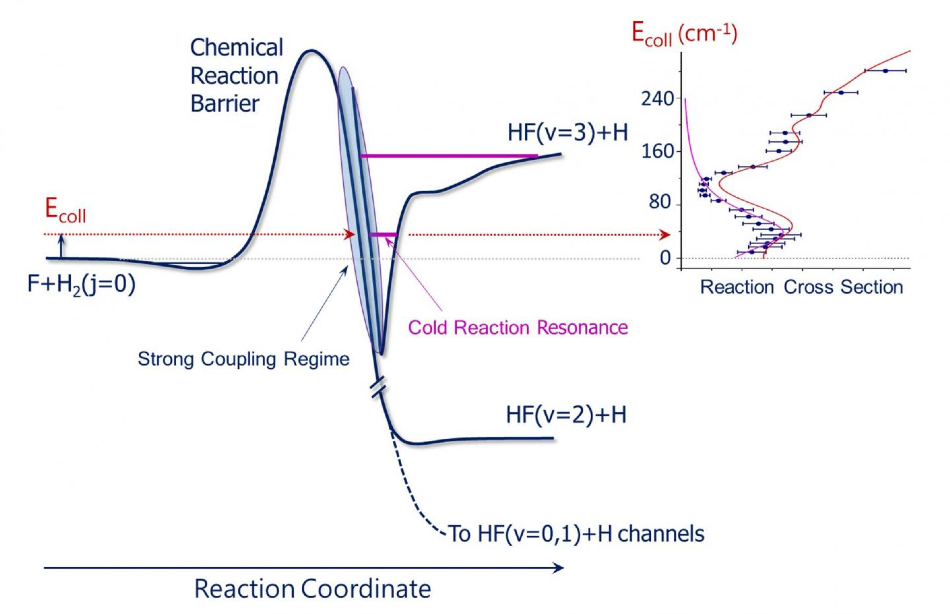May 8 2020
Major advances in investigating quantum resonances during collisions at the atomic and molecular levels at near absolute zero have been debated by Prof. YANG Xueming of the Dalian Institute of Chemical Physics of the Chinese Academy of Sciences and Prof. YANG Tiangang of the Southern University of Science and Technology.
 The schematic shows quasi-bound quantum resonance state in the post barrier region, which is responsible for the enhanced reactivity in the F+H2 to HF+H reaction at a temperature near absolute zero. Image Credit: DICP.
The schematic shows quasi-bound quantum resonance state in the post barrier region, which is responsible for the enhanced reactivity in the F+H2 to HF+H reaction at a temperature near absolute zero. Image Credit: DICP.
Their paper was published in the Science journal on May 7th, 2020.
All collision processes at the atomic and molecular levels are governed by the rules of quantum mechanics. It is crucial to gain insights into the quantum nature of atomic and molecular collisions to understand chemical reaction and energy transfer processes, specifically in the low collisional energy region in which the quantum effect is the most prominent.
In atomic and molecular collision, a fascinating attribute of quantum nature is quantum scattering resonances. However, it has been highly difficult to probe them experimentally due to the transient nature of these resonances.
This study introduces a quantum resonance investigation reported in the same issue of Science by a research team from the University of Nijmegen. De Jongh and colleagues used a cryogenic helium beam and the Stark decelerated molecular beam of NO(j = 1/2f) in combination with high-resolution velocity map imaging method. Thus, they were able to observe resonances in the NO+He inelastic collisions at the 0.3–12.3 K temperature range.
Precise quantum dynamics calculations are in high accordance with experimental results. A specifically fascinating fact is that the resonances can only be precisely characterized using a new NO-He potential energy surface (PES) at the CCSDT(Q) level. This shows the very high precision of the resonance picture created for this standard inelastic collision system.
Apart from inelastic scattering processes, the researchers also discussed resonances in chemical reactive collisions in the low collision energy regime. The study also discussed a crucial benchmark system for reaction resonances, the F+H2 to HF+H reaction, which is a predominant source of HF formation in interstellar clouds (ISC).
It is known that the F+H2 reaction has a major reaction barrier (629 cm−1), and thus its reactivity should be insignificant at the near absolute zero temperature. It is vital to gain insights into the HF formation mechanism by this reaction at the cold temperatures, which can help ascertain hydrogen column density in space.
Using the optimized molecular crossed beam apparatus, the F reaction and H2 have been analyzed at a temperature as low as 14 K (9.8 cm−1) at the State Key Laboratory of Molecular Reaction Dynamics, DICP.
The researchers identified a clear resonance peak at the collision energy of ~40 cm−1, which leads to the improved reactivity at the temperature near absolute zero, from the comprehensive analysis of dynamics on a precise PES. Due to the resonance enhanced quantum tunneling, this reaction should have abnormally high reactivity at temperatures below 1 K.
Further theoretical analysis demonstrated that elimination of the contribution of resonance-enhanced tunneling from the reactivity led to a reduction in the reaction rate constant of F + H2 below 10 K by more than three orders of magnitude.
In this study, the researchers noted that strong interaction between theory and experiment has been vital to study the transient collision resonances.
The study of dynamics in atomic and molecular collisions is specifically crucial to gain insights into the chemical reaction and energy transfer processes that could have a major effect on complex systems, like interstellar clouds, terrestrial and planetary atmospheres, semiconductor processing, gas-phase lasers, combustion processes, and plasmas.
Journal Reference:
Yang, T & Yang, X (2020) Quantum resonances near absolute zero. Science. doi.org/10.1126/science.abb8020.